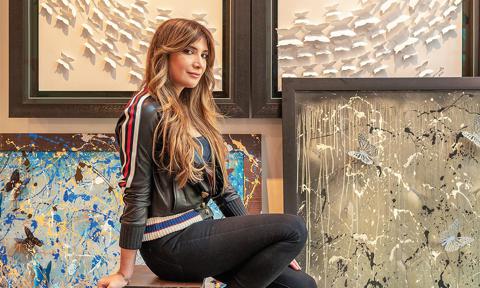
Michelle Poonawalla needs no introduction to the world of art. For that matter, to the world of haute couture either. A gifted artist who has traversed the various facets of the field, from sculptures and graffiti to varied forms of paintings, she leaves her distinct mark in any medium she chooses. Well known for the butterfly motifs she favours in both her art and outfits, Poonawalla is a passionate environmentalist and dynamic entrepreneur, who has had her artwork showcased at prestigious events and international museums. HELLO! is enthralled as the elegant lady updates us on her artistic accomplishments.
HELLO: In February, you unveiled ‘The Striped Tiger’ for WWF’s AR-mazing Tiger Trail at the National Museum of Singapore. How did it feel to be one of only three Indians chosen for this exhibition?
Michelle Poonawalla: Coming from India, one of the very few countries to still have tigers in the wild, the project is very close to my heart. It was an honour to be chosen alongside two other leading Indian artists, Subodh Gupta and Bharti Kher.
H: You partnered with the Women’s Supercar Club of India for their inaugural drive, where you showcased some of your graffiti work. What made you collaborate with them?
MP: My family has always had an interest in cars and art, and they shared their passion with me. I joined hands with the Women’s Supercar Club because art and car collaborations like these are focused on common interests and aesthetics. Art and auto together is an age-old collaboration; one complements the other well. Most of all, I felt it was important to lend my support to a women-led initiative. It’s great to see women working together and sharing their passion projects with each other.
H: Butterflies are a recurring motif in your art. We also spotted them at the HELLO! Hall of Fame Awards. What do you try to convey with them?
MP: I started working with butterflies as part of a project with Gateway School of Art in Mumbai, working with a group of autistic children. We made art for their spring- summer show, and the theme I chose back then was butterflies. Since then, the butterfly motif has been a constant in my work. It symbolises many things — it reminds us of the fragility of life, of freedom, hope and love.
H: You’ve chosen varied venues and events to showcase your artwork. Were these conscious decisions?
MP: Yes, I have exhibited my work at various venues around the world — from the Saatchi Gallery in London to the Kochi-Muziris Biennale and Alserkal Avenue in Dubai, as well as traditional galleries like Tao Art Gallery in Mumbai and 079 Stories in Ahmedabad. It’s always been vital to me that my work is seen by as many people as possible, so I’m open to showcasing my art at varied venues. I try to choose venues that complement my art from a curatorial standpoint.
H: You want your audience to interpret your art in different ways and take the effort to reflect on your work...
MP: I think different people interact with artwork at their own pace, in their own time. Even if they aren’t engaging with physical artwork on a regular basis, I’m sure they are looking at their phones, be it on Instagram or even Netflix! They are interacting with some kind of creativity in one way or another. Going to a museum or a gallery isn’t the only way to consume art. For example, my seminal installation ‘Introspection’ addressed many ongoing issues in the world, but the work was meant to make the viewer stop and spend time drawing their own conclusions and thoughts on these issues. It’s about creating a meditative process for people to stop, look and take the time to reflect.
H: Your grandfather Jehangir Vazifdar was an illustrious artist. Share a few memories you can recollect of him, especially in relation to art.
MP: I’ve been painting since I was a child, when I spent a great deal of time with my grandfather. He was an avid painter and renowned architect. I grew up hearing about his theories on art, watching him sketching at his office desk daily. My grandfather had a very special technique with a ruler in oil painting, which he shared only with me. It’s important for me to carry on his legacy. He was my mentor, and I’m happy I was able to learn from his advice.
H: You shuttle between London and Pune. How does this global lifestyle work out for you?
MP: I like to observe my surroundings and take inspiration from my environment. For example, my Seasons Series was inspired by my garden at home in Pune, and my Graffiti Series was inspired partly by London, a city known for its iconic street art. Spending summers in London also allowed me to access some of the best art institutes in the world. They have great exhibitions there, especially at the V&A and Tate Modern, where they have works by Picasso, Frida Kahlo and Yayoi Kusama on display.
This story has been adapted for the website from a story that was originally published in HELLO! India’s June 2022 issue. Get your hands on the latest issue right here!
- Quick links
- Art
- artist
- Michelle Poonawalla






